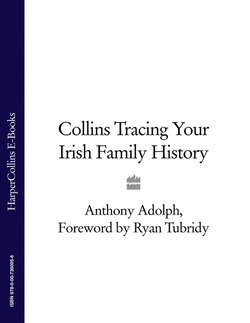Читать книгу Collins Tracing Your Irish Family History - Ryan Tubridy, Anthony Adolph - Страница 24
Civil Registration records
ОглавлениеMost countries have a system of civil registration (sometimes called General Registration) of births, marriages and deaths. Some started very recently, but most of the countries that received Irish immigrants have systems that started in the 19th century – often, in fact, coinciding with the Irish Diaspora, making them particularly useful.
Usually, your mining of family knowledge will result in a family tree starting with a name (‘John or maybe James O’Brien’) followed by their child, with a bit more information (say, ‘Thomas O’Brien, born in 1922’), and then a third generation down, with much more definite information (‘Ellen O’Brien, born on 22 February 1951, Lismore, New South Wales’). You may think you’ll save money and time if you start with John (or James!), but then what will you look for? Starting with Thomas would be better, as you can look for a birth in 1922, but as you don’t know where he was born you’ve no idea where to look, and you’re probably not 100 per cent sure that the year 1922 was correct – this might be a year calculated from an age at death, and these seldom take into account when in the year people’s birthdays fell – so Thomas could have been born in 1921 (or 1923!). Therefore, start with what you know for sure, and seek Ellen’s birth certificate. Once you have this, you’ve established a firm foothold, and can work back with confidence.
Generally, birth records tell you when and where the child was born, the names of both parents and the father’s occupation. Some countries’ records will give more, such as when the parents married.
The birth certificate is a contemporary source providing the parents’ names, probably from their own mouths – not half-remembered hearsay, then, but fact. Now, work back through the marriage indexes, seeking their wedding. Marriage certificates usually state names, occupations and places of residence of the couple, their ages and names of parents – either just fathers, or sometimes mothers too. Thus, following our example, you’ll now have a definite age for Thomas, and know his father’s name (James, not John), all recorded at the time, from the people concerned. Sometimes they lied about ages – if you discover discrepancies, you’ll simply have to widen the period of your subsequent search. The next step is to seek Thomas’s birth: if his father’s name matches the one given on his marriage record, you’ll know you have the right document.
A major problem in seeking births is when you have very common combinations of names, leaving a long list of possible entries. This can sometimes be overcome by building up a picture of all families of the surname in the area, using civil registration and religious registers, thus eliminating false possibilities. Where possible, gain extra co-ordinates on ages from census returns.
Try to confirm the names of both parties (i.e. from a birth certificate) before seeking marriage records. You can then work back from when the eldest known child of the couple was born (beware that a census may list all the children of a father, but won’t let on that half of them were by his present wife, and the other half by a previous, now deceased spouse: a significant gap in children’s ages may alert you to this). Choose the least common surname or combination of names, and whenever you find an instance of it, look for the other party’s name in the index: if the other details (district, volume and page number) match up, it’s yours.
Occupations could change. If the father on a 1950 marriage certificate was a factory manager, and on a 1922 birth certificate was a junior clerk, you can see that the clerk could have been promoted to factory manager. If, however, you find an implausible jump from, say, army officer to fishmonger, then you may have the wrong certificate, and should widen your search for better possibilities. Only when you’re sure you’ve found the right document should you continue working backwards.
Death certificates vary in use from country to country. Those in Ireland just give the age and place of death. This is useful if you are stuck – it will suggest when the person was born, if you can’t (say) find their marriage record. It’s good to seek these records to complete your ancestors’ stories anyway, and it’s helpful to confirm that someone who you think was your ancestor died after their child was born, not some years before! Countries such as Scotland and New Zealand have much more detailed death certificates including both parents’ full names, making them fantastic tools that should be sought as a matter of course. Just bear in mind that names of the deceased’s parents as supplied by their children may not be accurate, for the informants may never have met their grandparents. But only disbelieve what you read if you have firm evidence to the contrary.
Deaths can be hard to find without knowing when the event took place. It’s often easier to gain further co-ordinates: marriage entries sometimes state that a father was deceased, for example. Will indexes provide a short-cut for better-off families. In Ireland, Griffith’s Valuation (see p. 84) for any landholder, however small, can give a good idea when someone may have died.
If civil registration reaches back to your migrant ancestor, then the earliest documents will actually name people living in Ireland. For example, if your migrant ancestor married after having already migrated, then the father’s/parents’ names on the marriage certificate will be those of people back in Ireland. The same applies to parents’ names on a migrant’s death certificate. Of course, the parents may have migrated too, so you can always seek their deaths in the country of arrival too, just in case!
